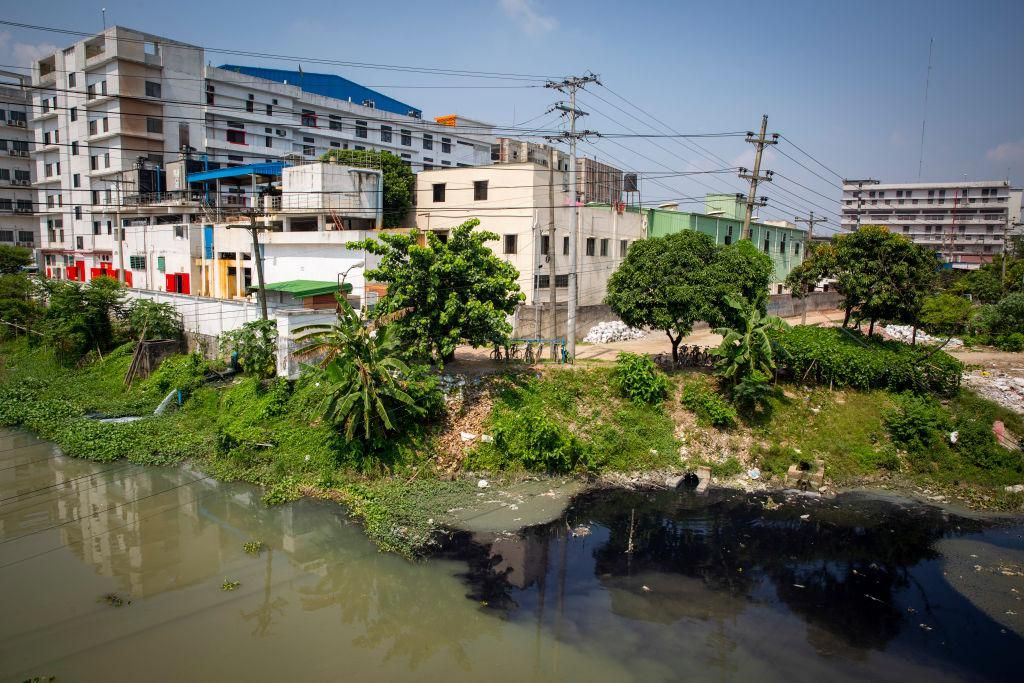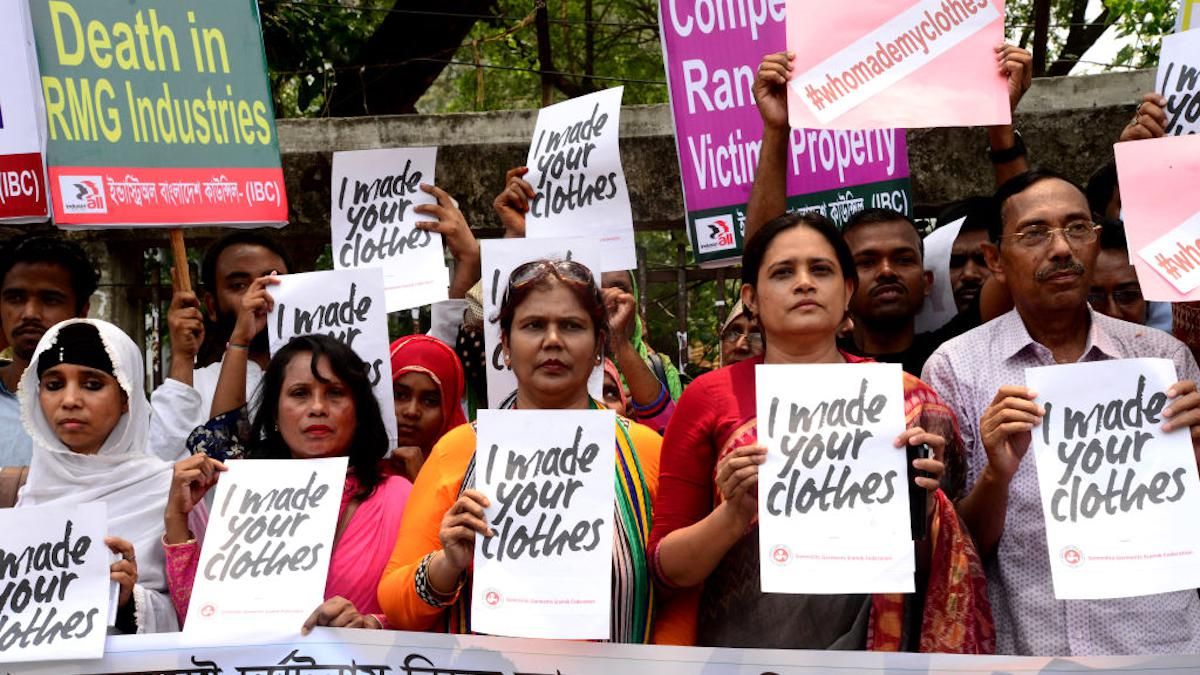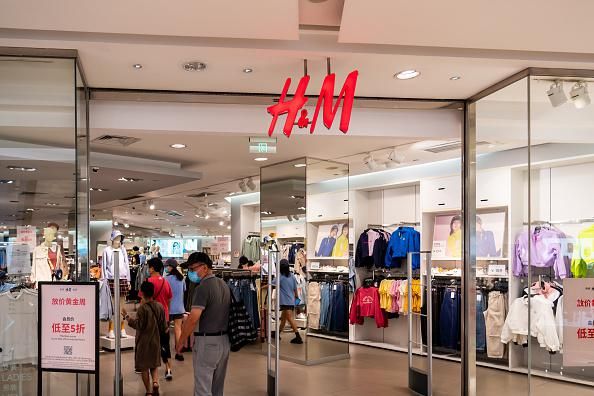Fast Fashion 101: Everything You Need to Know

Garment workers in a textile mill in Gazipur, Bangladesh on March 18, 2021. Kazi Salahuddin Razu / NurPhoto via Getty Images
 Why you can trust us
Why you can trust us
Founded in 2005 as an Ohio-based environmental newspaper, EcoWatch is a digital platform dedicated to publishing quality, science-based content on environmental issues, causes, and solutions.
It’s not your imagination — fashion trends don’t last as long as they used to. While in decades past, style enthusiasts could expect new releases once per season, today’s trending looks seem to change every few weeks. Anyone who wants to stay fashion-forward must buy new pieces as they become available or risk looking out of date.
The result? An unsustainable clothing industry that does more than give you FOMO — it’s wreaking havoc on the planet and the people who produce it.
What Is Fast Fashion?
“Fast fashion” refers to mass-produced clothing that’s made quickly, cheaply, and in trending styles. The goal of fast fashion marketers is to get runway styles into shoppers’ hands as quickly as possible, no matter the quality or external costs.
These trendy pieces tend to be of poor quality, and most won’t last more than a few wash cycles. But that’s no hardship for the buyer because they didn’t invest much to begin with.
Fast fashion has upended the clothing industry. It’s turned updating your wardrobe from a semi-annual investment to the equivalent of ordering takeout. The trend towards disposable clothing is taking over the world, but it didn’t happen all at once.
How Fast Fashion Got Started
Prior to the Industrial Revolution, individuals were primarily responsible for sourcing materials to make their clothes. Starting in the 18th century, inventions like the power loom and the sewing machine took clothes making out of the house and into the garment factory, which scaled up production in unprecedented ways.
Even so, clothing costs stayed relatively high for the following centuries. Dresses in the 1950s cost about $70 to $100 in today’s money. By the 1960s, the Average American bought just two dozen pieces of clothing each year — all made in the United States — and spent more than 10% of their income to do so.
The 1970s harkened a massive change in clothing manufacturing as factories started leaving the U.S. in favor of cheaper labor in Asia and Latin America. The result was cheaply made, mass-produced clothing, and shoppers scaled up their buying habits accordingly. Americans spend less than 4% of their budget on clothes each year but bring home about new 70 pieces, one of which might be made domestically.
Cheaper production is only part of the story of fast fashion. Innovations in supply chain management made it possible to get trending styles in shoppers’ hands faster, which sped up the entire fashion cycle. While designer labels once released four collections a year, many have now increased the turnover rate to 20+ unique collections in the same timeframe.
The Consequences of Fast Fashion
Why is fast fashion bad? It turns out that lower prices and the quicker turnover of trends has significant impacts on the planet.
Increases Carbon Emissions
Considering their short lifespan, fast fashion clothes have an outsize carbon footprint.
The Ellen MacArthur Foundation blames the fashion industry for 10 percent of global CO2 emissions — more than all international flights and shipping combined. That’s primarily due to the long transportation journeys that textiles take from manufacturing to purchasing and their eventual disposal.
Polyester production alone emits more than 700 million tons of greenhouse gases each year, and some estimate the 2030 annual levels will be as high as 1.5 billion.
Overproduces Toxic Textiles
Fast fashion manufacturers cut corners whenever possible to keep costs low. Most pieces are made from ultra-cheap synthetic materials that won’t break down in landfills.
Even natural fibers like cotton take a toll. Cotton is a thirsty crop that requires upwards of ten gallons per plant, pulling precious water resources away from food crops in many growing regions. Commercially grown cotton is a heavy feeder that requires large amounts of synthetic fertilizer but still depletes and degrades the soils it’s planted in.
This disposable clothing doesn’t even spend long in your closet. According to the Ellen MacArthur Foundation, Americans throw away about 70 lbs of textiles each year. This results in 17 million tons of annual waste, of which just 2.5 tons are recycled.
Pollutes Water Systems
Dyeing cheap clothes involves a toxic cocktail of chemicals. Denim production alone is the second-largest polluter of fresh water on the planet. An estimated 70% of Asia’s lakes and rivers are contaminated by over 2.5 billion gallons of waste from the textile industry, resulting in a massive ecological and public health crisis.
Xintang, China, considered the denim capital of the world, has recorded evidence of toxic heavy metals associated with jeans production in more than three-quarters of water testing sites. The problem is so extreme that it’s becoming almost impossible to convince people to live in the region.
Another problem is that polyester sheds microfibers after every wash cycle. These trace materials land in the water system. There, they increase the ocean’s plastic concentration and disrupt marine food chains. Studies show these tiny fibers end up in animal stomachs and even make it onto our plates within seafood.

Black water probably dye enters the river from a factory, environmental pollution on the river banks surrounding some of the textile industry buildings of Savar Upazila on 30th September 2018 in Dhaka, Bangladesh. Andrew Aitchison / In pictures / Getty Images
Harms Animal Welfare
Even animals aren’t immune to the effects of fast fashion. The ever-expanding clothing industry requires massive amounts of land for factories and fiber production. This concentrates pollution and fragments habitat space for wild animals, which leads to declines in biodiversity.
Domestic animals don’t fare much better, as cutting costs for leather, fur, and wool production often leads to animal abuse. In one noteworthy case, real fur from tortured dogs and cats was passed off as fake because it was cheaper to produce it illegally than to use synthetic alternatives.
Leads to Human Rights Abuses
Fast fashion might be cheap at the store, but someone else is paying the full price. The textile industry has been built around workers’ rights abuse since the Industrial Revolution.
Garment workers today work extreme hours for poverty wages, often in dangerous conditions. In 2013, the Rana Plaza factory in Bangladesh collapsed due to shoddy construction, killing 1,100 people and injuring another 2,500. This was hardly an isolated incident, as hundreds of Bangladeshi workers have died in factory fires over the past decade.
Children aren’t exempt from the challenges of producing cheap clothes. There are an estimated 168 million underage workers in the world today, many of them children pulled out of school to work in garment factories.
Why Do Consumers Turn a Blind Eye to Fast Fashion’s Flaws?
Considering the costs associated with cheap clothes, why are $20 jeans still widely available?
Put bluntly — most shoppers just don’t care enough to change their habits. As things stand today, fashion retailers rarely, if ever, lose out on significant numbers of customers due to poor environmental or labor practices.
Research shows that shoppers prioritize price over almost any other selling point, and that they are quick to forget when products are made unethically or unsustainably. Even in the aftermath of the Rana Plaza factory collapse, Americans still purchased millions of dollars worth of clothes from similar factories in Bangladesh that year.

Protesters demanding safe workplaces for garment workers mark the sixth anniversary of the of the Rana Plaza building collapse disaster in Dhaka, Bangladesh on April 24, 2019. Mamunur Rashid / NurPhoto via Getty Images
The fast fashion industry shows little sign of slowing down, and part of the blame lies with social media. Rather than waiting for print magazines to tell us what’s trendy, we can hop on our favorite celebrity’s Instagram to see their fashion-forward choices in real-time. Likewise, the rise of influencer culture and micro-marketing has created a subgroup of stars whose job it is to convince us to buy more.
The internet provides constant exposure to all the world’s trends at once, which speeds up the fast fashion cycle and leaves us forever feeling one step behind what’s stylish. One London-based survey from 2017 found that 41% of 18 to 25-year-olds felt pressure to wear different clothes every time they left the house.
In short, when every outfit is scrupulously documented for the socials, it becomes passé to wear the same clothes more than once.
What Companies Are Involved With Fast Fashion?
Both traditional and newly established clothing brands alike are responsible for fast fashion.
As the oldest fast fashion giant around today, mega-retailer H&M (short for Hennes and Mauritz) opened in Sweden in 1947 and only made it to the States in 2000. The company specializes in cheap runway knockoffs and a short supply chain. H&M doesn’t own factories but instead relies on 800 independent suppliers — mostly in Asia — to produce its apparel.

Customers at an H&M store in Shenzhen, Guangdong, China on Oct. 5, 2020. Alex Tai / SOPA Images / LightRocket via Getty Images
Zara offers similar speedy merchandise. This Spanish-based retailer has made it its mission to bring a garment from the design stage to store shelves in just three weeks — no matter the cost for the people and places producing it.
The company also strives to overwhelm shoppers with choice by producing more than 10,000 unique pieces each year (the industry average is 2,000-4,000), hoping that customers will come home with more apparel than they anticipated after every shopping trip.

People wait in line to shop at Zara in Boston, Massachusetts on Aug. 14, 2021. Erin Clark / The Boston Globe via Getty Images
Some fast fashion stores are feeling the pressure as online shopping further cheapens and speeds up the supply chain. Once a mall staple for teenage shoppers, Forever 21 filed for bankruptcy in 2019.
But compared to traditional retailers, internet-based brands have advantages in the world of fast fashion. They cut out the middleman of retail space, which eliminates display costs. This makes it cost-effective to manage a large, continually changing inventory that can be adapted as trends change.
And, because the stock from online retailers is constantly shifting, shoppers feel pressure to make impulse buys when they find pieces they like for fear the items will soon be unavailable.
Is your favorite apparel retailer suspect? Here are some of the common characteristics of fast fashion brands to avoid.
- Clothes are made outside the United States and Europe.
- The brand offers hundreds, even thousands of styles.
- There is a limited quantity of any specific style.
- The brand sells styles mere weeks after they are seen on celebrities or the runway.
- The clothing is made from low-quality material and wears out quickly.
How to Move Towards Sustainability With the Wardrobe
The news isn’t all bad. There is hope today to move the world of fashion in a more ecologically sound direction. But to be effective, this change has to happen both on an industry level and a personal level.
As Industries
Change is slow, but shoppers are showing more interest in alternative ways to get clothes, including renting and buying secondhand. Some retail giants, including select Macy’s locations, have started selling used clothing from ThredUp.
Other stores, such as H&M, are becoming more transparent about their supply chains and striving to make environmentally conscious improvements. These include retail-specific changes like powering its stores with renewable energy and expanding its clothing recycling programs.
Unfortunately, these improvements rarely address the far worse impacts of the clothing production process itself or the fashion world’s disturbing habit of burning unsold clothes to dispose of them.
Other brands, like Zara, are building a name for themselves in the sustainability sphere through limited-release collections made from organic cotton and other eco-friendly materials. In many cases, these collections make up a tiny portion of the company’s profits and effectively act as fast fashion greenwashing to distract attention from the problems with its primary clothing lines.
As Individuals
As long as there is demand for fast fashion apparel, brands will continue to supply it. For this reason, making real changes in the clothing world comes down to changing your buying habits.
One approach is to embrace the idea of slow fashion. When shopping, look for timeless, quality-made pieces that are versatile enough for a variety of outfits. The goal is to create a smaller, capsule wardrobe built around pieces you’ll wear frequently.
Buying less also means it’s easier to justify spending more per item. Research manufacturers for evidence of fair labor practices and environmentally sustainable manufacturing. Seek out natural materials when possible, and learn whether the company offers recycling or other sustainable end-of-life services for its garments.
Make each piece of apparel last longer with careful maintenance. Wash your clothes only when necessary, using gentle detergents that won’t break them down. You can also learn basic sewing skills to repair rips, lost buttons, and even broken zippers. One way to get more use out of any item is to get a tailor to modify it to your measurements. After all, trends come and go, but well-fitting clothes will always be in style.
To make a more significant impact, skip buying new altogether in favor of used clothes. The environmental cost has already been paid for these items, and by wearing them, you’ll keep the material out of landfills for a little longer. Traditional thrift stores can offer surprising bargains, or you can take the shopping online through resale sites like ThredUp, Poshmark, and even Facebook Marketplace or other local buy-sell groups.
If you can’t resist the allure of the latest fashions, consider renting instead of buying. Companies like Nuuly and Rent the Runaway offer more sustainable ways to try on trending clothes without them permanently taking up space in your wardrobe. Just note that there are high environmental costs associated with continually cleaning and shipping these clothes from one renter to another.

One person’s trash is another person’s treasure. Attending a clothing swap or taking the step to host one is a smart (and fun) way to recycle clothing and get a new wardrobe fast. AleksandarNakic / E+ / Getty Images
Takeaway
The world of fast fashion has run unchecked for far too long, and the planet is facing the consequences. It’s time to make changes to how you approach your own wardrobe in an effort to improve your personal impact.
So, buy less, buy smarter, and hold onto what you own for as long as possible. Making sustainable, slow fashion trendy is a proven way to take some of the sting out of the global clothing industry and fight back against fast fashion.
Lydia Noyes is a freelance writer specializing in health and wellness, food and farming, and environmental topics. When not working against a writing deadline, you can find Lydia outdoors where she attempts to bring order to her 33-acre hobby farm filled with fruit trees, heritage breed pigs, too many chickens to count, and an organic garden that somehow gets bigger every year.
Subscribe to get exclusive updates in our daily newsletter!
By signing up, you agree to the Terms of Use and Privacy Policy & to receive electronic communications from EcoWatch Media Group, which may include marketing promotions, advertisements and sponsored content.

 233k
233k  41k
41k  Subscribe
Subscribe 




